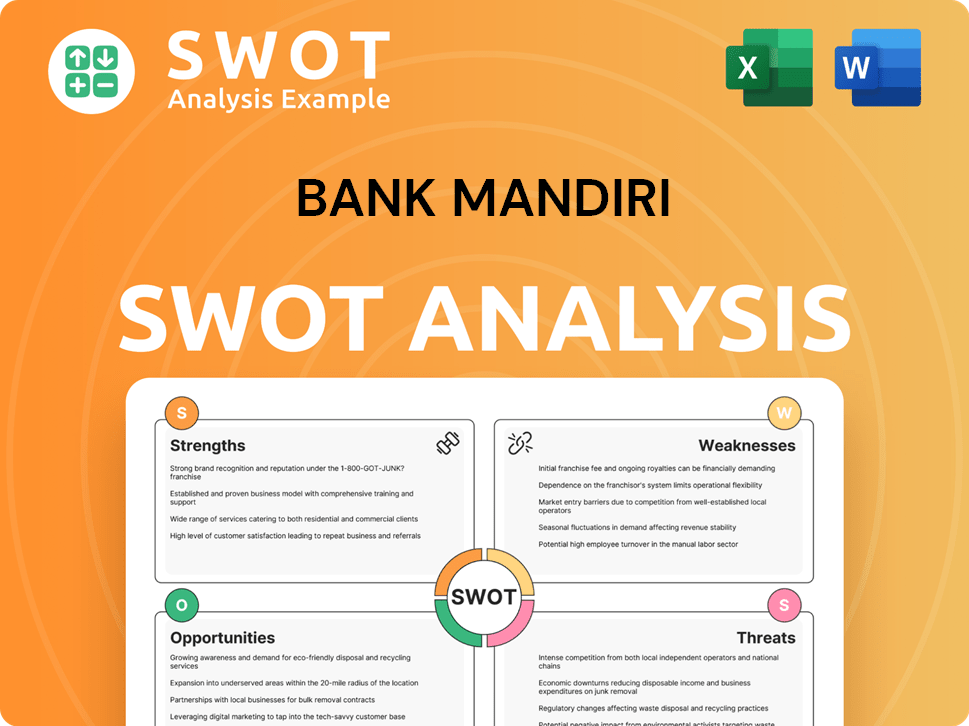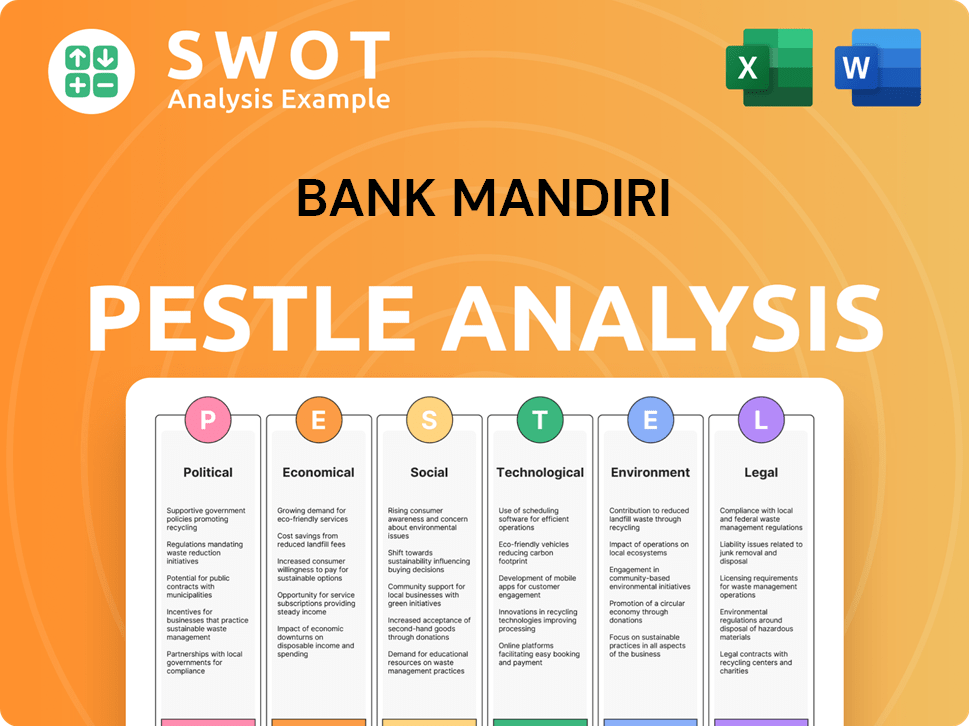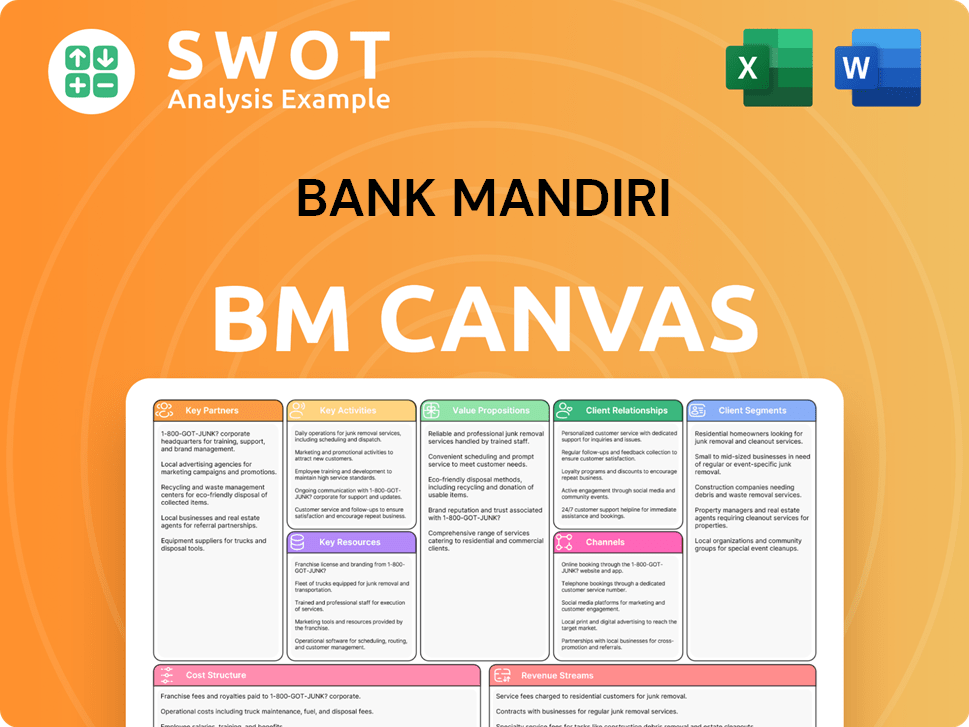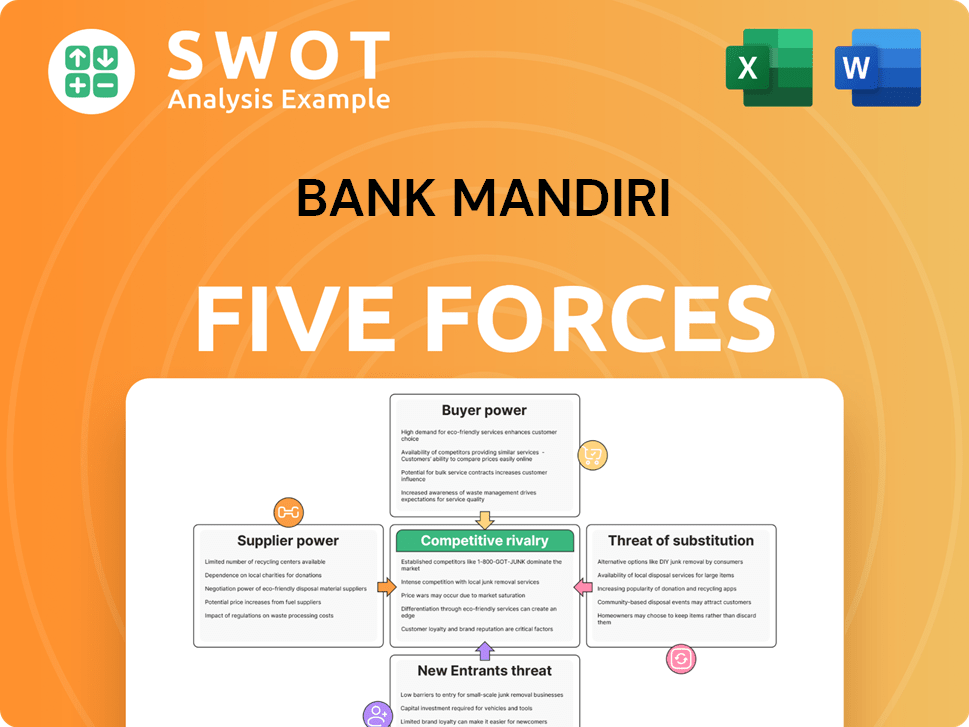Bank Mandiri Bundle
How Does Bank Mandiri Stack Up in the Indonesian Banking Arena?
Bank Mandiri, a powerhouse in Indonesia's financial sector, isn't just navigating the market; it's shaping it. Understanding the Bank Mandiri SWOT Analysis is crucial to grasp its position. This analysis will explore the dynamic interplay of Bank Mandiri's operations, from retail to investment banking, and how it competes in a rapidly evolving environment.

This deep dive into the Bank Mandiri competitive landscape will dissect its financial performance, including its impressive loan growth and asset size, offering insights into its market share and strategic direction. We'll examine Bank Mandiri's main competitors, evaluating their strengths and weaknesses within the Indonesian banking industry. Furthermore, we'll explore the bank's digital banking strategy and investment in technology, crucial elements shaping its future in the financial services market.
Where Does Bank Mandiri’ Stand in the Current Market?
Bank Mandiri holds a leading position in the Indonesian banking industry, primarily due to its substantial asset base and strategic growth initiatives. As of the end of 2024, it solidified its standing as the largest bank in Indonesia by assets. The bank's core operations encompass retail banking, corporate banking, investment banking, and treasury services, serving a diverse customer base across Indonesia and internationally.
The bank's value proposition revolves around providing comprehensive financial services, leveraging its extensive network and digital platforms. This includes offering a wide range of products and services tailored to meet the diverse needs of its customers, from individual consumers to large corporations. It emphasizes digital transformation to enhance customer experience and operational efficiency.
The bank's strategic focus in 2024 and outlook for 2025 highlight a continued emphasis on accelerating growth in both the wholesale and retail segments. The digital transformation efforts have significantly impacted its market positioning, with its flagship super app, Livin' by Mandiri, garnering significant user growth and transaction volumes. The bank aims to maintain a net interest margin (NIM) between 5-5.2% in 2025.
Bank Mandiri's market position is reinforced by its substantial asset base and strategic growth initiatives. The bank is the largest in Indonesia by assets. Total consolidated assets reached Rp 2,427 trillion by the end of 2024, marking an 11.6% increase from the previous year.
The bank demonstrated robust financial health in 2024. Consolidated net profit reached Rp 55.8 trillion, with a return on equity (ROE) of 21.2%. The non-performing loan (NPL) ratio improved to 0.97%.
Bank Mandiri's digital transformation efforts have significantly impacted its market positioning. Its flagship super app, Livin' by Mandiri, garnered 29.3 million users and processed 3.9 billion transactions in 2024, a 38% increase year-on-year.
The bank's strategic focus includes accelerating growth in both wholesale and retail segments. Corporate lending surged by 25.5% to Rp 913.3 trillion in 2024. Retail loans grew by 11%, with a target of 10-12% loan growth for 2025.
Bank Mandiri's competitive landscape is shaped by its extensive network, digital capabilities, and strong financial performance. Its large asset base and strategic focus on growth, particularly in the wholesale segment, reinforce its market leadership. The bank's digital initiatives, such as Livin' by Mandiri and Kopra by Mandiri, enhance its service offerings and customer engagement.
- Bank Mandiri's total consolidated assets reached Rp 2,427 trillion by the end of 2024.
- Corporate lending surged by 25.5% to Rp 913.3 trillion in 2024, reinforcing its position as a leading wholesale bank.
- The bank's consolidated net profit reached Rp 55.8 trillion in 2024, with a return on equity (ROE) of 21.2%.
- The bank's digital platform, Livin' by Mandiri, has 29.3 million users.
Bank Mandiri SWOT Analysis
- Complete SWOT Breakdown
- Fully Customizable
- Editable in Excel & Word
- Professional Formatting
- Investor-Ready Format

Who Are the Main Competitors Challenging Bank Mandiri?
The Indonesian banking industry is highly competitive, and the Bank Mandiri competitive landscape is shaped by a mix of state-owned and private institutions. The bank faces significant competition across various segments, from retail and corporate banking to digital financial services. Understanding Bank Mandiri competitors and their strategies is crucial for assessing its market position and future prospects.
Bank Mandiri analysis reveals a dynamic environment where market share shifts and competitive pressures are constant. The rise of digital banking and the increasing focus on customer experience further intensify the competition, requiring continuous innovation and adaptation to stay ahead. The bank's strategic moves, including collaborations and technological investments, are key to navigating this complex landscape.
Bank Mandiri's main competitors in Indonesia include other state-owned banks, with Bank Rakyat Indonesia (BRI) and Bank Negara Indonesia (BNI) being the most prominent. These banks have extensive branch networks and offer a wide range of financial services, competing directly with Mandiri across various customer segments.
BRI is a major competitor, particularly in the micro, small, and medium enterprises (MSME) sector. BRI's strong presence in this segment creates direct competition for Mandiri market share and loan distribution. BRI's focus on rural and underserved markets gives it a significant advantage in customer acquisition.
BNI competes with Mandiri across various segments, including corporate and retail banking. BNI often targets high-value clients and competes for market share in key sectors. Both banks aim to expand their digital banking capabilities to enhance customer experience and operational efficiency.
Private national banks also pose a significant competitive challenge. These banks often focus on specific market niches or customer segments, employing aggressive marketing strategies and innovative products. They compete with Mandiri for market share and customer loyalty.
New and emerging players, particularly fintech companies and digital-only banks, are disrupting the traditional Indonesian banking industry. They offer agile, tech-driven solutions and often target younger, digitally-native customer segments. These companies pressure established banks to accelerate their digital transformation.
Mergers and alliances significantly impact competitive dynamics. Bank Mandiri is a central player in Danantara, a sovereign wealth superholding aimed at boosting the performance of SOEs. This could lead to increased collaboration among state-owned entities, reshaping the competitive environment.
Bank Mandiri's competitive strategy involves leveraging its extensive network, brand recognition, and digital capabilities. The bank is focused on enhancing customer experience, expanding its digital services, and diversifying its product offerings to stay competitive.
- Extensive Branch Network: Mandiri has a vast network of branches and ATMs across Indonesia, providing broad accessibility to its services.
- Digital Transformation: The bank is investing in technology to improve its digital banking platform, enhance user experience, and offer innovative financial solutions.
- Strategic Partnerships: Mandiri collaborates with fintech companies and other financial institutions to expand its service offerings and reach new customer segments.
- Customer Focus: Mandiri emphasizes customer service and aims to build strong relationships with its clients to increase loyalty and retain market share.
- Diversified Services: Offering a wide range of financial products, including loans, deposits, and investment services, helps Mandiri cater to diverse customer needs.
For a deeper dive into the financial aspects, consider exploring the Revenue Streams & Business Model of Bank Mandiri.
Bank Mandiri PESTLE Analysis
- Covers All 6 PESTLE Categories
- No Research Needed – Save Hours of Work
- Built by Experts, Trusted by Consultants
- Instant Download, Ready to Use
- 100% Editable, Fully Customizable

What Gives Bank Mandiri a Competitive Edge Over Its Rivals?
The competitive landscape for Bank Mandiri is shaped by its extensive reach and digital innovation. As a leading player in the Indonesian banking industry, it leverages its vast distribution network and technological advancements to maintain a strong market position. The bank's strategic moves, particularly in digital banking, have been key to its competitive edge, allowing it to serve a broad customer base and adapt to evolving market demands. For more context, consider reading about the Brief History of Bank Mandiri.
Bank Mandiri's focus on digital transformation, evident in platforms like Livin' by Mandiri and Kopra by Mandiri, has significantly enhanced its competitive advantages. These platforms offer integrated financial solutions, contributing to customer satisfaction and operational efficiency. Its commitment to building a strong funding base through transactional CASA and value chain growth further solidifies its position in the financial services market.
The bank's brand equity and customer loyalty, combined with economies of scale, contribute to its robust financial health. This is reflected in its strong financial performance, including a low non-performing loan (NPL) ratio and disciplined cost management. These strengths enable Bank Mandiri to optimize operational efficiencies and offer competitive pricing, setting it apart from its Bank Mandiri competitors.
Bank Mandiri's widespread physical infrastructure, including numerous branches and ATMs across Indonesia, provides a significant competitive advantage. Its international presence further extends its reach. This extensive network allows it to serve a wide range of customers, from large corporations to micro-enterprises, enhancing its market share.
The bank's investment in proprietary technologies and digital platforms like Livin' by Mandiri and Kopra by Mandiri is central to its competitive edge. Livin' by Mandiri had over 29.3 million users by the end of 2024, with transaction frequency growing by 38% year-on-year. Kopra by Mandiri doubled its corporate users to 200,000 in Q1 2024.
As a state-owned enterprise and the largest bank by assets in Indonesia, Bank Mandiri benefits from strong public perception. This trust translates into a substantial low-cost funding base, with CASA contributing 80.3% of total Third Party Funds (DPK) in 2024. This reinforces its position in the Indonesian banking industry.
Bank Mandiri's large size enables it to optimize operational efficiencies and potentially offer competitive pricing. The bank's cost-to-income ratio improved slightly to 41.8% in 2024. Its robust financial health, with a low non-performing loan (NPL) ratio of 0.97% and a strong NPL coverage of 271% as of December 2024, underscores its prudent risk management.
Bank Mandiri's competitive advantages are multifaceted, encompassing its extensive distribution network, digital innovation, brand equity, and economies of scale. These strengths contribute to its robust financial performance and market position.
- Extensive Branch and ATM Network: Provides widespread accessibility across Indonesia.
- Digital Platforms: Livin' by Mandiri and Kopra by Mandiri drive customer engagement and efficiency.
- Strong Brand Reputation: Benefits from being a state-owned enterprise, fostering trust.
- Operational Efficiency: Achieved through economies of scale and disciplined cost management.
Bank Mandiri Business Model Canvas
- Complete 9-Block Business Model Canvas
- Effortlessly Communicate Your Business Strategy
- Investor-Ready BMC Format
- 100% Editable and Customizable
- Clear and Structured Layout

What Industry Trends Are Reshaping Bank Mandiri’s Competitive Landscape?
The Indonesian banking industry is undergoing significant transformation, driven by technological advancements, evolving regulations, and shifting consumer behaviors. This dynamic environment presents both challenges and opportunities for institutions like Bank Mandiri. Understanding the Bank Mandiri competitive landscape is crucial for stakeholders seeking to assess its market position and future prospects.
Bank Mandiri's market share and competitive standing are influenced by its strategic responses to industry trends. These include investments in digital platforms, adaptation to regulatory changes, and efforts to meet evolving customer expectations. The bank's performance is also affected by broader economic factors and the strategies of its Bank Mandiri competitors.
Technological advancements, particularly in digital banking and AI, are reshaping the sector. Regulatory changes, such as BI's reference rate adjustments, influence banking operations. Consumer preferences increasingly favor convenient, integrated digital financial services, driving the need for innovation.
Continued pressure on funding costs is anticipated, despite strong loan growth targets. Fintechs and digital banks pose a continuous threat by offering specialized services. Global economic shifts and geopolitical tensions can impact the rupiah and investment.
Significant growth opportunities exist in emerging markets and product innovations. Strategic partnerships, such as with PT Huadian Bukit Asam Power, offer integrated financial solutions. Focus on driving loan growth in productive sectors like infrastructure and green energy.
Emphasis on digital transformation, prudent risk management, and diversification of revenue streams. Expanding ecosystem banking, accelerating SME digitization, and embedding ESG principles into financing decisions. Strategic national initiatives, like Danantara, position Bank Mandiri as a key player in economic transformation.
In January 2025, BI cut its reference rate by 25 basis points to 5.75%. Bank Mandiri aims to maintain a net interest margin (NIM) between 5-5.2% in 2025. The bank expects the cost of credit to normalize between 1-1.2% in 2025.
- Bank Mandiri's digital platform, Livin', saw a 38% increase in transactions in 2024.
- The bank's 2025 roadmap includes operationalizing AI across the enterprise.
- The bank's revised GDP growth forecast for Indonesia in 2025 is 4.93%.
- Bank Mandiri is focused on driving loan growth in productive sectors. For more details on the company's vision, read about the Growth Strategy of Bank Mandiri.
Bank Mandiri Porter's Five Forces Analysis
- Covers All 5 Competitive Forces in Detail
- Structured for Consultants, Students, and Founders
- 100% Editable in Microsoft Word & Excel
- Instant Digital Download – Use Immediately
- Compatible with Mac & PC – Fully Unlocked

Related Blogs
- What are Mission Vision & Core Values of Bank Mandiri Company?
- What is Growth Strategy and Future Prospects of Bank Mandiri Company?
- How Does Bank Mandiri Company Work?
- What is Sales and Marketing Strategy of Bank Mandiri Company?
- What is Brief History of Bank Mandiri Company?
- Who Owns Bank Mandiri Company?
- What is Customer Demographics and Target Market of Bank Mandiri Company?
Disclaimer
All information, articles, and product details provided on this website are for general informational and educational purposes only. We do not claim any ownership over, nor do we intend to infringe upon, any trademarks, copyrights, logos, brand names, or other intellectual property mentioned or depicted on this site. Such intellectual property remains the property of its respective owners, and any references here are made solely for identification or informational purposes, without implying any affiliation, endorsement, or partnership.
We make no representations or warranties, express or implied, regarding the accuracy, completeness, or suitability of any content or products presented. Nothing on this website should be construed as legal, tax, investment, financial, medical, or other professional advice. In addition, no part of this site—including articles or product references—constitutes a solicitation, recommendation, endorsement, advertisement, or offer to buy or sell any securities, franchises, or other financial instruments, particularly in jurisdictions where such activity would be unlawful.
All content is of a general nature and may not address the specific circumstances of any individual or entity. It is not a substitute for professional advice or services. Any actions you take based on the information provided here are strictly at your own risk. You accept full responsibility for any decisions or outcomes arising from your use of this website and agree to release us from any liability in connection with your use of, or reliance upon, the content or products found herein.